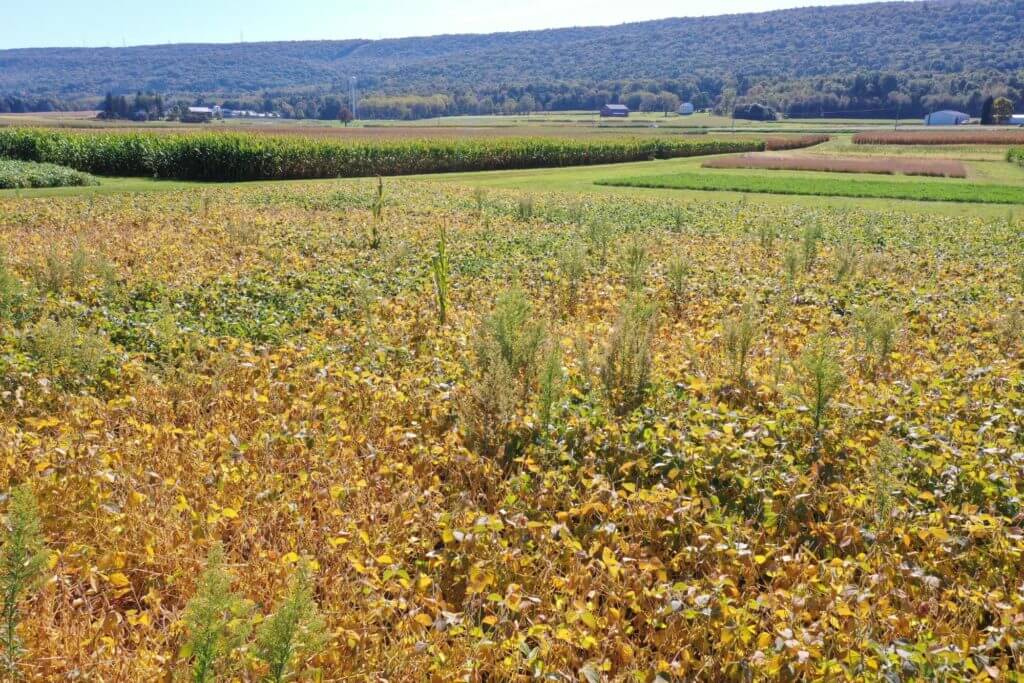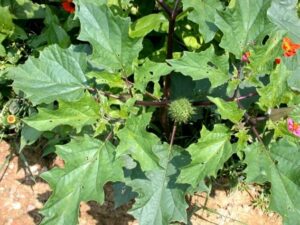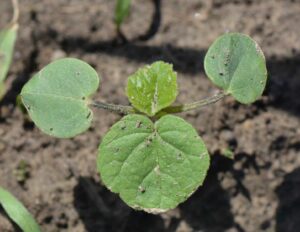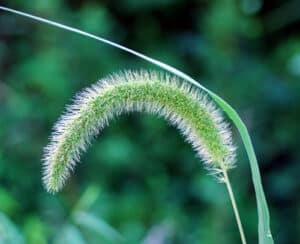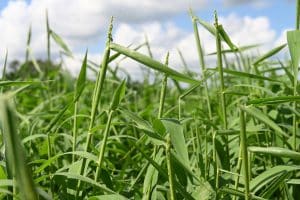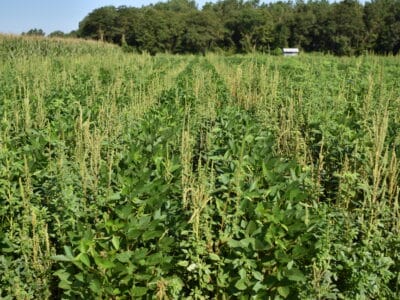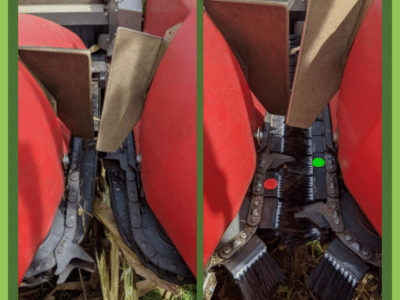Horseweed
Erigeron canadensis L.
(syn. Conyza canadensis (L.) Cronquist)
Also known as marestail, Canadian fleabane, and Canadian horseweed
Biology
Horseweed is a particularly problematic weed because of the large number of seeds a single plant can produce, potential for long-distance dispersal of that seed, prolonged germination periods, and widespread herbicide resistance.
Where is horseweed a problem?
Horseweed is found throughout the US in roadsides, fallow areas, and agricultural fields. In agricultural settings, horseweed tends to be more prevalent in reduced or no-till systems where seeds remain at the soil surface because the small seed requires light for germination. The increased adoption of reduced tillage farming practices has increased the establishment of this weed species. Surveys of horseweed populations taken in Indiana showed that horseweed was present in 61% of no-till fields, 24% of reduced tillage fields, and 8% of conventionally tilled fields.
What is the emergence pattern of horseweed?
This weed can be classified as a winter or summer annual and has two germination windows: one in the fall (approximately August through December) and one in the spring (approximately March through May), depending on location and local conditions. Not only are there multiple germination windows, but these windows are prolonged compared to many other weed species and emergence is often variable from year-to-year within these windows. The multiple, long germination windows can make horseweed control much more difficult because repeated control tactics are needed as a single approach or single timing is unlikely to provide control over such a long period of time.
Since horseweed germinates in the fall and early spring, seedlings are often large and well established by the time summer crops are planted. If these individuals are not controlled prior to planting they can become very competitive with summer crops and cause significant yield loss.
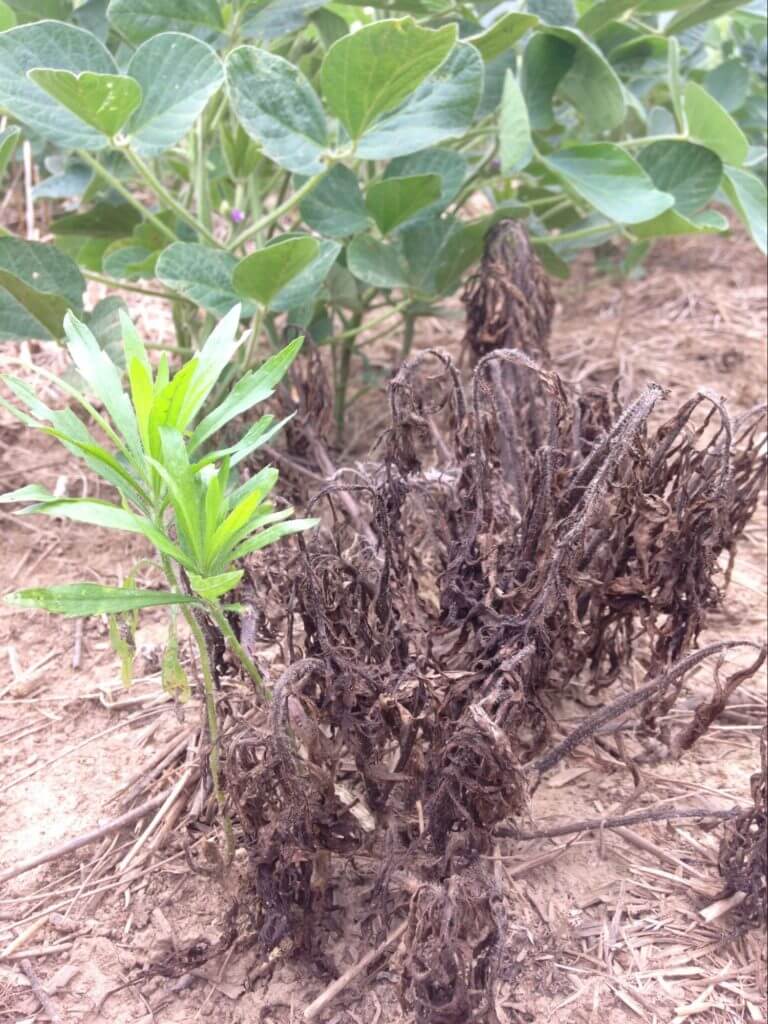
What is the lifecycle of a horseweed plant?
Once horseweed germinates, it will grow vegetatively as a rosette, in which all leaves originate from a central point. Horseweed plants that germinate in the fall will overwinter in this rosette stage while plants that germinate in the spring will spend less time in this growth stage.
As the season progresses, the plant will bolt and a central stem will grow out of the center of the rosette. At this point the plant is still growing vegetatively with the plant gaining size rapidly, making control much more difficult. In mid- to late-summer a cluster of branching flower stems form at the top of this bolted stem.
Example graph:
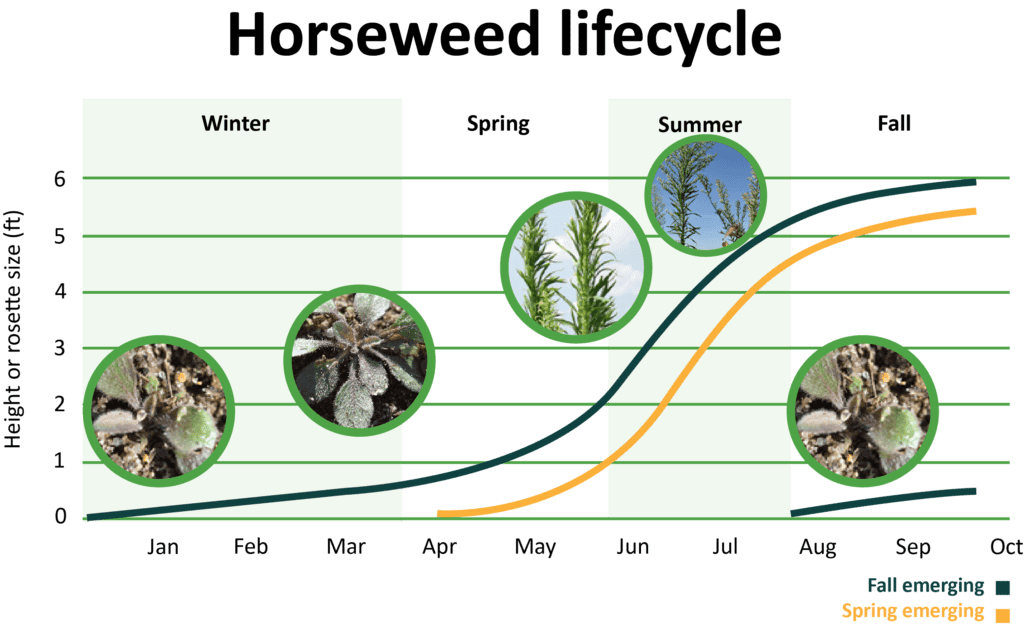
How does horseweed spread?
Horseweed only reproduces by seed. These seeds have a feather-like appendage (pappus) that aids in wind dispersal, much like dandelion seeds. There have been reports of horseweed seed spreading up to 300 miles by wind. With this ability to spread over long distances, fields can be infested even when good management practices are implemented, which is why repeated scouting is necessary. While most horseweed seeds are wind-dispersed, seeds can also be dispersed by water or with human assistance on vehicles or farm equipment.

How many seeds can a horseweed plant produce and how long can those seeds survive?
Horseweed plants flower in late summer and can produce up to 200,000 seeds per plant. These seeds are very likely to mature by late summer/early fall and are typically dispersed before cash crop harvest. Because this weed relies on the wind to disperse seeds, when seeds are mature they are easily dislodged from the plant and carried away with even a slight breeze. This biological trait makes this species unsuitable as a candidate for harvest weed seed control (HWSC) techniques that rely on seed retention on plants until harvest.
Horseweed seeds are relatively short-lived in the soil with most seeds not surviving more than three years. Seeds have very little dormancy and most will easily germinate when conditions are favorable, which is typically within the two germination windows mentioned above. Horseweed seeds will not germinate if buried deeper than 0.2 inches in the soil profile.
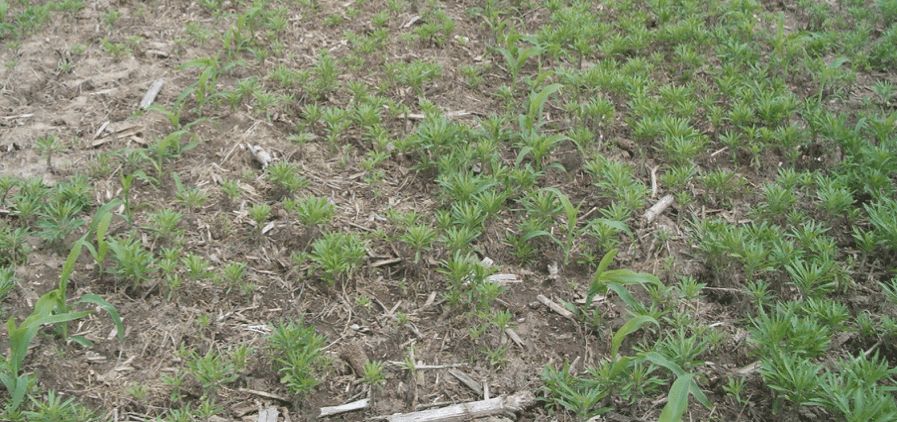
Photo Credit: Barb Scott, University of Delaware.
The combination of short seed longevity and inability to germinate from below the soil surface make this species susceptible to tillage as a control tactic.
What other biological weaknesses does horseweed have that can be targeted with management techniques?
The weakest point in a horseweed plant’s life cycle is the seed. Horseweed is an annual which has to reproduce by seed. These seeds are small, short-lived, and can not germinate from deep in the soil. The seeds also need light to trigger germination so practices like cover cropping or a dense crop canopy can limit germination. Management efforts should focus on suppressing weed seed germination through practices such as tillage and cover cropping, and preventing plants from producing viable seed.
Herbicide Resistance
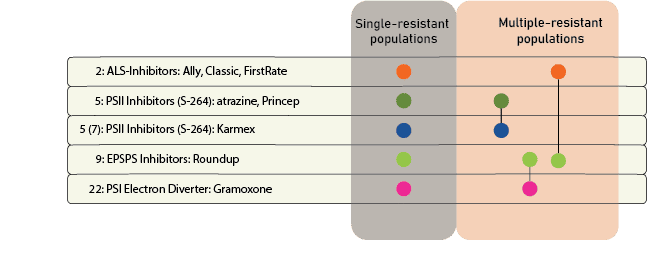
Contact your local extension office for details about resistance in your area and management options.
*Herbicide names listed are not the only products that contain these specific active ingredients. Please check herbicide labels for more information. Last updated on: 6-18-20
Integrated Weed Management Strategies
Cultural Tactics: Competitive cash crops will delay or reduce germination, growth, and seed set of many weed species. For horseweed, the spring emergence window is ending or has already ended at the time of cash crop planting so efforts for control are better focused prior to planting. In some areas, where the horseweed germination window extends into the growing season, narrow row spacing can help the cash crop reach canopy more quickly and compete with young horseweed plants.
Crop rotation: is one cultural tactic that can impact horseweed density. Crop rotation provides the opportunity to diversify weed management tactics, preventing and combating herbicide resistance. Studies have shown that a soybean-corn crop rotation can reduce horseweed density compared to planting continuous soybean. Corn is typically planted earlier than soybeans so this rotation allows for herbicide application earlier in the spring while the horseweed plants are smaller; residual herbicides applied to corn also prevent much of the spring emergence flush. There are also different herbicide options available for these crops.
Crop residues can play a role in suppressing fall-germinating horseweed. Studies in Tennessee have found that corn residue providing 75% ground cover reduced horseweed density the following May by 79 to 81% compared to where there was no crop residue and 49 to 75% compared to fields with soybean residue. Any tactic that will increase the amount of ground cover such as not removing crop stover or planting a cover crop, will help suppress horseweed. However, relying on these tactics alone will not keep horseweed at bay for a full cropping season.
With horseweed, repeated scouting is necessary because of the weed’s long, unpredictable germination periods and its ability to spread long distances. It can be easy to miss a flush of germination or a new infestation without repeated scouting.
Cover Crops: Winter cover crops have the unique ability to suppress horseweed in both fall and spring. In the fall, actively-growing cover crops prevent light from reaching the soil (decreasing horseweed germination) and compete with existing weed seedlings for light, moisture and nutrients; in the spring, the residue from terminated cover crops likewise discourages horseweed germination and emergence.
Generally, 7,000 lbs per acre of cover crop biomass is needed to suppress weeds, but it is not known how much biomass is needed to suppress horseweed specifically. High biomass cover crops have the potential to suppress horseweed early in the cash crop growing season but as the cover crop residue degrades, horseweed can emerge and still be a weed of concern in the field.
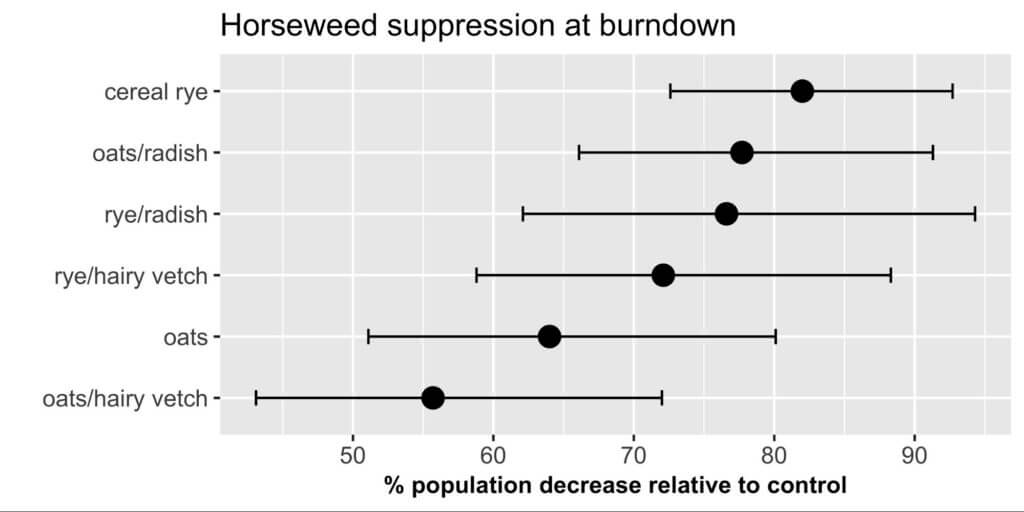
In this study conducted in Pennsylvania, cover crops were seeded in the fall, and soybeans were planted the following spring. Horseweed seedling density was collected just prior to killing the cover crop with a burndown herbicide application.
All cover crops reduced horseweed density by 55 to 80% compared to no cover crop. While cereal rye offered the greatest suppression, all cover crop treatments reduced the number of horseweed plants, including forage radish. Forage radish winterkilled in this study but it has the potential to contribute to horseweed suppression during the fall emergence window.
Not only did cover crops reduce the number of horseweed rosettes, the size of the rosettes was reduced in the presence of cover crops compared to the no cover control. Where cereal rye was grown, most of the horseweed rosettes were less than 1.5” in diameter; in the no-cover check most of the weeds were 1.5 – 2.5” in diameter. The smaller size makes the rosettes more susceptible to a herbicide application.
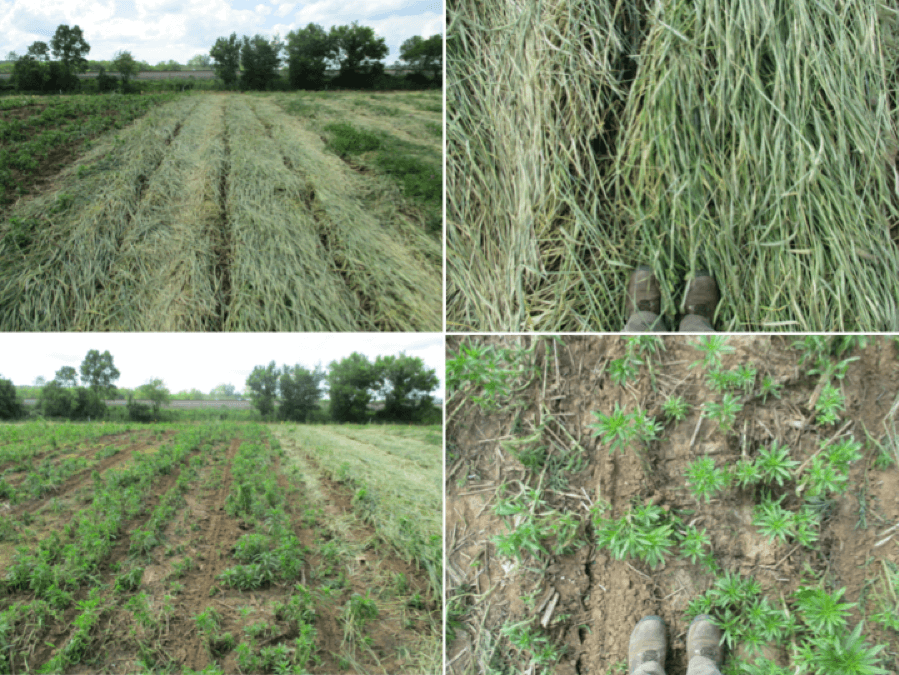
Photo Credit: Kara Pittman, Virginia Tech.
Video 1: Horseweed Management With Cover Crops in Soybeans
In this video with Dr. John Wallace (Penn State), you will learn about horseweed biology, why horseweed is difficult to manage, and how to use a high biomass cover crop to decrease horseweed stand and seed production.
Edits: Victoria Ackroyd, University of Maryland.
Video edits and content: Claudio Rubione, University of Delaware.
Video 2: Horseweed Management in Cotton With Cover Crops
Weed management in cotton has been challenging in past years, particularly given the spread of herbicide-resistant species such as horseweed and Palmer amaranth. In this video, Dr. Charlie Cahoon, weed specialist at North Carolina State University, shows what integrated weed management can achieve when cover crops are included in a weed management program.
Video edits and content: Claudio Rubione, University of Delaware.
Mechanical: Tillage can be used as a control tactic to manage horseweed since seeds are small and require light for germination, so germination is greatly reduced once the seeds are buried by even a little bit of soil. The increase in reduced tillage acreage has favored horseweed spread and establishment.
Aggressive tillage practices will have the greatest effect on horseweed by burying weed seeds or uprooting plants. Reduced tillage practices, such as vertical tillage, are not as effective plowing or aggressive disking for seedlings and often will not have much of an effect on larger horseweed or bury seed enough to keep them from germinating.
Studies have shown that no seedlings will germinate when buried more than 0.2 inches.
Studies from Nebraska demonstrated tillage alone was very effective in controlling horseweed, with fall tillage reducing densities by 88% and spring tillage reducing densities by 94%. Tillage was more effective than any single herbicide application in the fall or spring. Herbicide use in combination with tillage or sequential herbicide applications provided up to 99% reduction in horseweed plants. Mechanical weed control was effective in this study, but an integrated weed management strategy is critical for managing herbicide resistance.
While tillage can contribute heavily to horseweed management, in some instances tillage for weed management is not desirable because of potential trade-offs, such as cost or the reduction in erosion control. In those instances, there are alternative tactics that are effective for controlling horseweed.
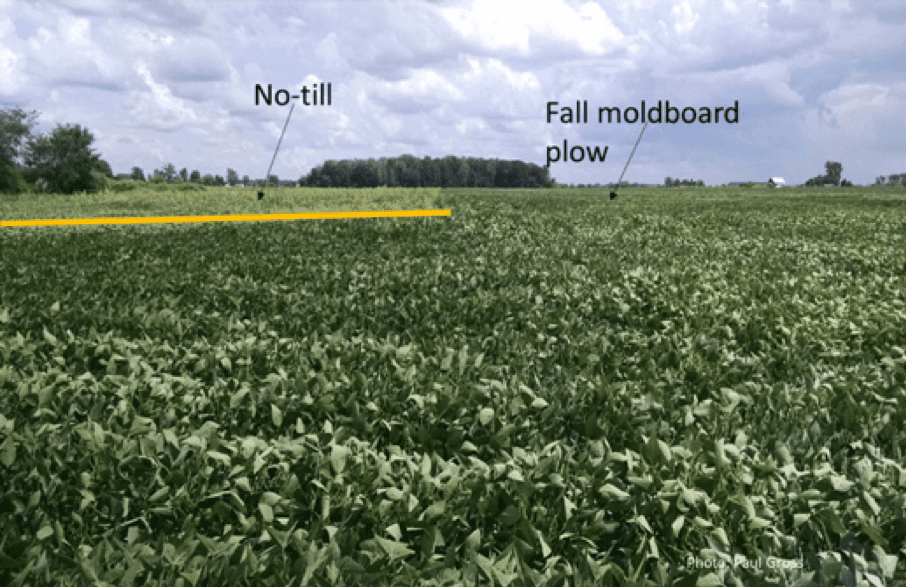
Photo: Difference in horseweed density by tillage type. The area of the field to the left was no-till and the field area on the right was moldboard plowed in the fall.
Photo Credit: Paul Gross, Michigan State University.
Chemical: Horseweed should be controlled when small, preferably in the rosette stage. Once the plants begin to bolt, control becomes more difficult. Control timing can be problematic because of the multiple and prolonged germination windows.
Control is very important prior to planting crops as there aren’t always options for adequate control in-crop, especially with soybeans and cotton. Burndown herbicides, such as 2,4-D, dicamba, glufosinate (Liberty), saflufenacil (Sharpen), paraquat (Gramoxone), or tank mixes of these herbicides, can be applied in the fall or spring to control horseweed. Additionally, waiting until after planting to manage horseweed typically means the plants are too large for adequate chemical control.
Glyphosate will control susceptible horseweed but resistance to glyphosate is widespread across the United States. Including residual herbicides in a preplant application can extend weed control until crop canopy closure. Examples of soybean herbicides include flumioxazin (Valor), sulfentrazone (Authority products), or metribuzin; corn herbicides include atrazine and mesotrione (Callisto); and cotton herbicides include flumioxazin (Valor) and fluometuron (Cotoran). Refer to herbicide labels for appropriate uses and rates in your area. Due to herbicide resistance, there may be fewer options to control horseweed postemergence in many crops. Refer to your local extension’s weed management guide for effective postemergence options.

Photo credit: Dwight Lingenfelter, Penn State.
For more information on chemical horseweed management, visit:
https://growiwm.org/factsheets/managing-herbicide-resistant-horsweed-marestail/
Biological: Currently, there are no commercially available biological control agents for horseweed. However, research has identified bacteria that can control horseweed; a commercial product has yet to be formulated.
Similar Weed Species
Conyza bonariensis, or hairy fleabane, is a species similar to horseweed. The distribution of hairy fleabane in the US is found in the southern and western states whereas horseweed has been reported in all fifty states.
These plants look similar but hairy fleabane leaves appear more greyish than horseweed and can have multiple stems elongating from the rosette, as opposed to a single stem like horseweed. At maturity, horseweed tends to be much taller than hairy fleabane and horseweed has the potential to produce more seeds per plant than hairy fleabane (200,000 compared to 85,000, respectively).
Worldwide, there have been reported cases of herbicide resistance in hairy fleabane similar to what has been reported in the United States. While there are some biological differences between the two species, management strategies are very similar.
Authors
- Kara Pittman
Editors
- Victoria Ackroyd
- Michael Flessner
- Claudio Rubione
- Mark VanGessel
Reviewed by
- Erin Haramoto, University of Kentucky
- Erin Burns, Michigan State University
Resources
Heap I (2019) The International Survey of Herbicide Resistant Weeds. Accessed online at http://weedscience.org/ on July 8, 2019
Loux M, ed. (n.d.) Management of herbicide resistant horseweed (marestail) in no-till soybeans. Take Action. Accessed online at https://growiwm.org/factsheets/managing-herbicide-resistant-horsweed-marestail/ on December 17, 2019.
Loux M, Stachler J, Johnson B, Nice G, Davis V, Nordby D (2006) Biology and management of horseweed. The Glyphosate, Weeds, and Crops Series. GWC-9. Accessed online at https://www.extension.purdue.edu/extmedia/GWC/GWC-9-W.pdf on November 12, 2019
Shrestha A, Hembree K, Wright S (2008) Biology and management of horseweed and hairy fleabane in California. University of California Division of Agriculture and Natural Resources. Accessed online at https://anrcatalog.ucanr.edu/pdf/8314.pdf on November 3, 2019
Citations:
Bajwa AA, Sadia S, Ali HH, Jabran K, Peerzada AM, Chauhan BS (2016) Biology and management of two important Conyza weeds: a global review. Environmental Science and Pollution Research 23:24694-24710. doi.org/10.1007/s11356-016-7794-7
Buhler DD (1992) Population dynamics and control of annual weeds in corn (Zea mays) as influenced by tillage systems. Weed Science 40:241-248. doi.org/10.1614/WS-D-13-00150.1
Davis VM, Gibson KD, Bauman TT, Weller SC, Johnson WG (2007) Influence of weed management practices and crop rotation on glyphosate-resistant horseweed population dynamics and crop yield. Weed Science 55:508-516. doi.org/10.1614/WS-06-187.1
Chahal PS, Jhala AJ (2019) Integrated management of glyphosate-resistant horseweed (Erigeron canadensis) with tillage and herbicides in soybean. Weed Technology 33:859-866. doi.org/10.1017/wet.2019.74
Holm L, Doll J, Holm E, Pancho J, Herberger J (1997) Conyza canadensis (L.) Cronq. (syn. Erigeron canadensis L.) Pages 226 – in World Weeds: Natural histories and distribution. New York: John Wiley & Sons, Inc. books.google.com
Main CL, Steckel LE, Hayes RM, Mueller (2006) Biotic and abiotic factors influence horseweed emergence. Weed Science 54:1101-1105. doi.org/10.1614/WS-06-026R1.1
Nandula VK, Eubank TW, Poston DH, Koger CH, Reddy KN (2006) Factors affecting germination of horseweed (Conyza canadensis). Weed Science 54:898-902. doi.org/10.1614/WS-06-006R2.1
Tozzi E, Van Acker RV (2014) Effects of seedling emergence timing on the population dynamics of horseweed (Conyza canadensis var. canadensis) Weed Science 62:451-456. doi.org/10.1614/WS-D-13-00150.1
Vargas AAM, Agostinetto D, Zandona RR, Fraga DS, Avila Neto RC (2018) Longevity of horseweed seed bank depending on the burial depth. Planta Daninha 36:e018172073. doi.org/10.1590/s0100-83582018360100050
Weaver SE (2001) The biology of Canadian weeds. 115. Conyza canadensis. Canadian Journal of Plant Science 81:867-875. doi.org/10.4141/P00-196
Wallace J, Curran W, Mortensen D (2019) Cover crop effects on horseweed (Erigeron canadensis) density and size inequality at the time of herbicide exposure. Weed Science 67:327-338. doi.org/10.1017/wsc.2019.3

